Affiliate disclosure: This post may contain affiliate links. Please see our Privacy Policy.
Blackberry wine is the perfect way to make use of a huge crop of summer blackberries. This one-gallon blackberry wine recipe can easily be increased to make a full 5-gallon batch if you have plenty on hand.
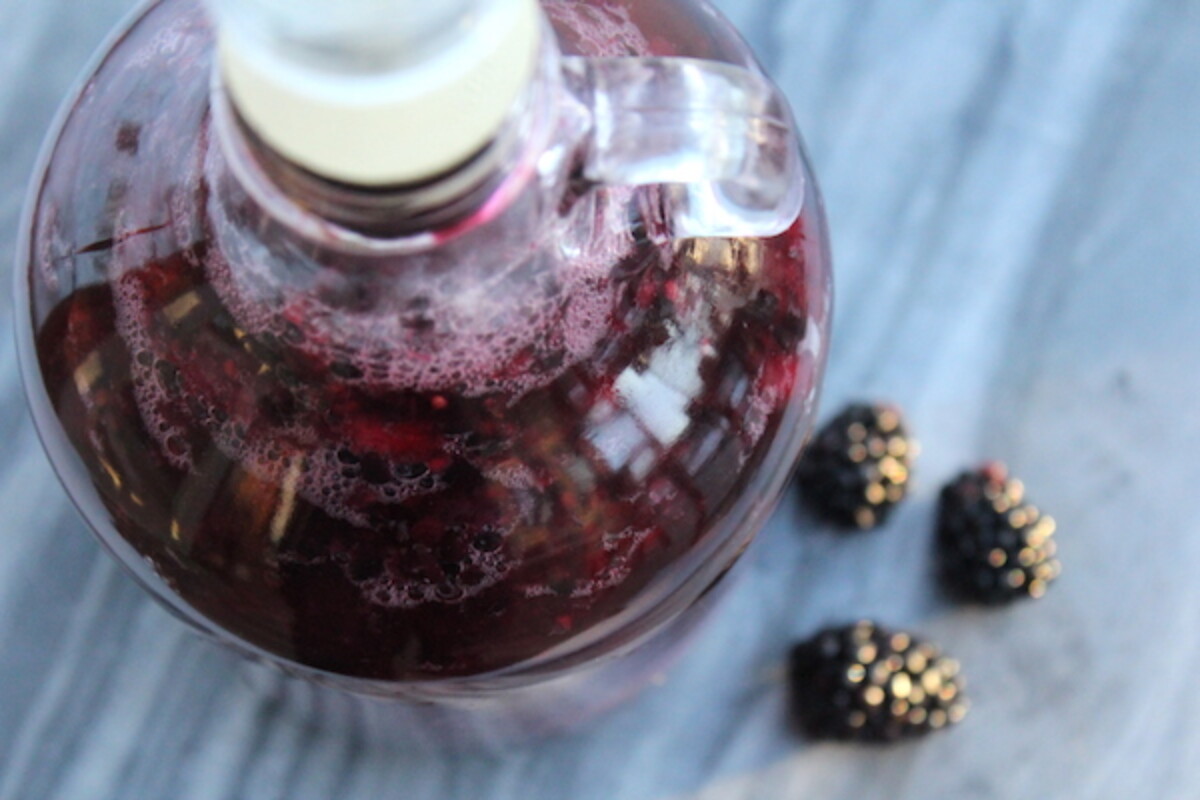
Wild blackberries are everywhere in Vermont, and we grow blackberries in our garden too, so we always have buckets of fresh blackberries in the summertime.
Much of our crop is gobbled up right out in the field, but once our stomachs are full it comes home in buckets for preserving.
Blackberry jam is a must of course, or you can make blackberry jelly if you prefer seedless preserves. And fresh blackberry pie always makes an appearance at my house before the season is over.
I’ve started canning whole blackberries for use in winter cobblers and that works wonderfully as well. In all the blackberry feasts of summer, don’t forget to make a batch of blackberry wine.
When there’s enough around to pick them by the 5-gallon bucket full, it’s no trouble to pull some aside for sweet blackberry wine.
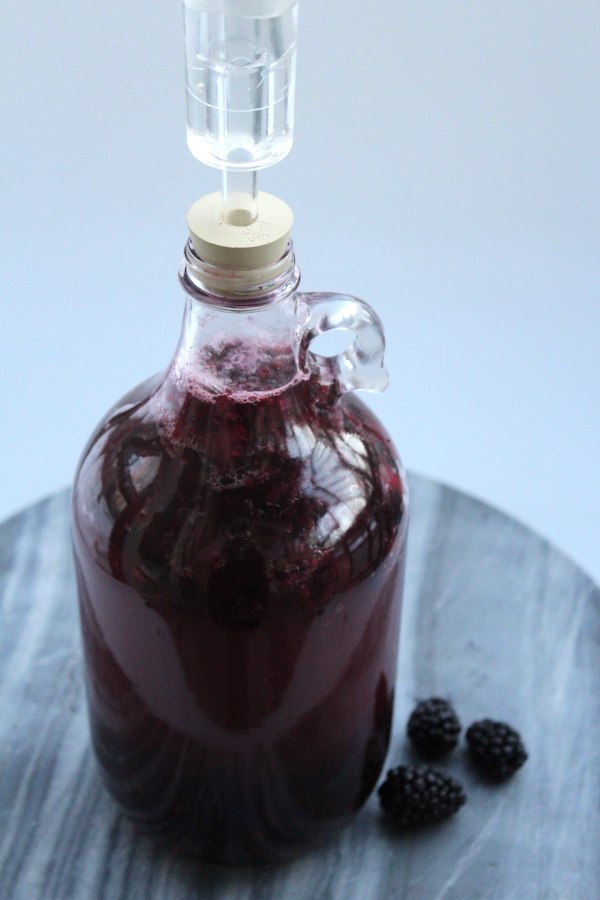
This recipe is adapted from The Home Winemakers Companion. The book describes it as follows:
“This is an outstanding dessert wine, well suited to many sweets like black forest cake, fruit pies a la mode, cheesecake, and fruit tarts. It is a reasonably easy wine to make and will earn accolades from friends and relatives.”
I like the fact that this recipe does not include any chemical stabilizers, but the original recipe had other fruits besides blackberries.
The author included a full pound of mashed bananas and 1/4 pound of raisins as well. I’ve removed those and added more blackberries instead, and it makes sourcing ingredients for the recipe simpler.
The bananas aren’t there for flavor, they’re actually added to help give the wine more body and a fuller mouthfeel. If you’d feel that the finished wine is a bit thin, you can substitute some of the sugar for honey for the same effect.
The raisins in the original recipe are a source of yeast nutrients, to help give the yeast a balanced diet. Grapes are a complete food, but other fruits are often lacking in nutrients yeast needs to thrive.
I’ve added powdered yeast nutrient instead, which still feeds the yeast but won’t impact the flavor of the finished wine as raisins would. If you don’t have yeast nutrients, feel free to use 1/4 lb of raisins instead.
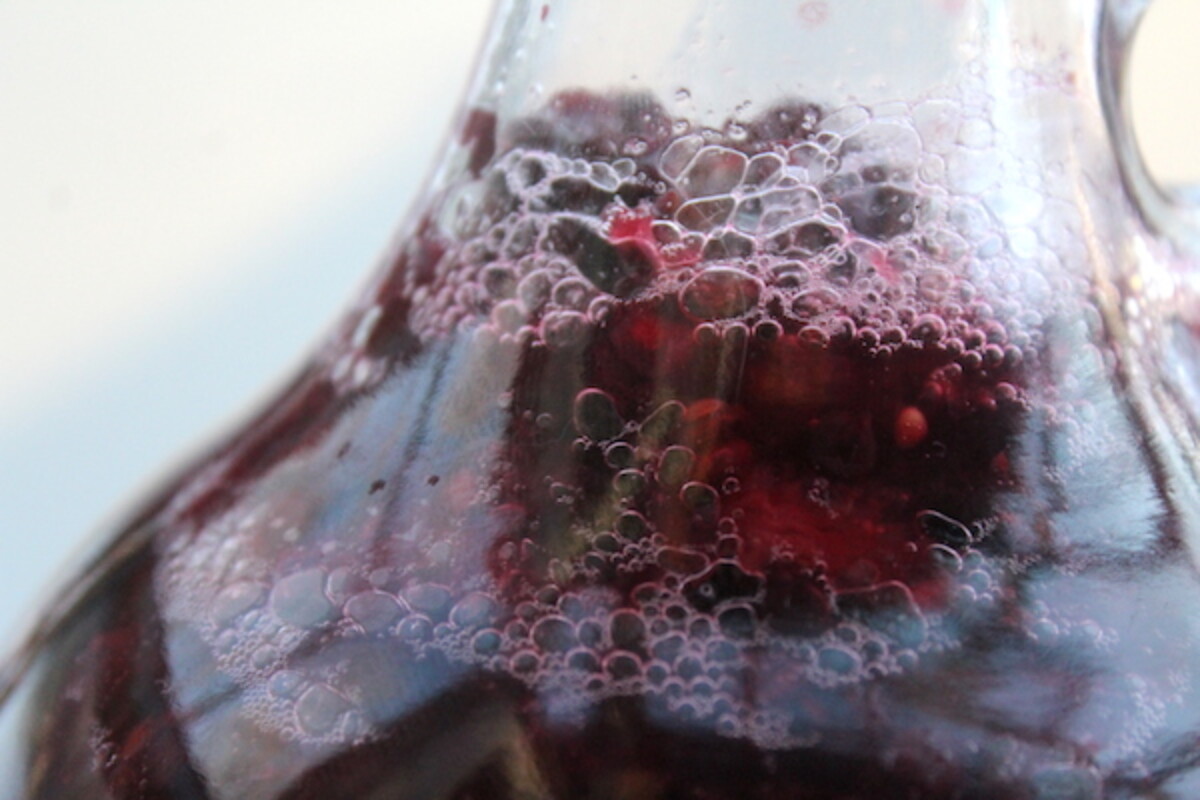
The recipe also specifically calls for Wyeast Mead Sweet Yeast, which finishes with a heavy-bodied sweet wine. That particular yeast packet is a bit expensive and might be worth the investment for a big 5 or 6-gallon batch. For a one-gallon batch, try this one which also finishes sweet but is much more economical to buy in dried form.
You can also go with a generic Premier Blanc wine yeast which works well in just about any wine. The downside is it has a much higher alcohol tolerance, so your blackberry wine will be on the dry side (with more alcohol and residual sugar).
Watch yourself during the primary ferment. This blackberry wine fermented more violently than any in my recent memory.
While most wine, cider, and beer recipes have you start the batch with either an open fermenter or a blow-off tube, I often don’t bother. I have kids running around, and a cat who loves to jump into anything, so I usually just seal it up in a standard narrow neck one-gallon jug with a water lock.
I check the fermenter every 8 to 10 hours to make sure it’s not bubbling up into the water lock, but usually, it’s not a problem.
Not this time…
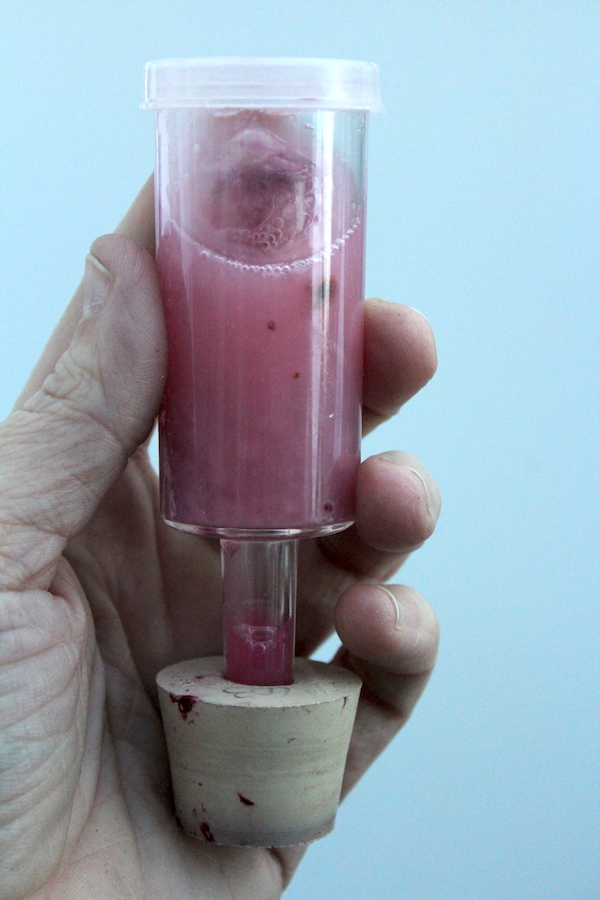
I made peach wine with big chunks of fruit in it without a problem, and even the matted flower petals from dandelion wine didn’t make their way into the water lock.
This blackberry wine is hell-bent on blowing up and it’s not stopping anytime soon. No more than an hour or two goes by without an eruption, so be warned.
I actually ended up filtering all the fruit out of the mixture after 24 hours, and moving the mixture into half-gallon mason jars with simple silicone water locks from Mason tops. These water locks are much easier to clean and they’re perfect for use in a primary ferment.
The silicone has a tiny pressure valve nipple that forms a water lock without water. They’re usually used for making vegetable ferments, but there’s no reason not to use them for winemaking and they work great.
But anyhow, I’d recommend you start off right and begin your primary fermentation in a bucket or open fermenter covered with a towel. Let it go for a few days to a week before filtering out the fruit pieces and moving the blackberry wine to a narrow neck fermenter.
(Unless you already happen to have some silicone mason jar water locks because you also make sauerkraut or Lacto-fermented pickles at home, cause those work nicely too.)
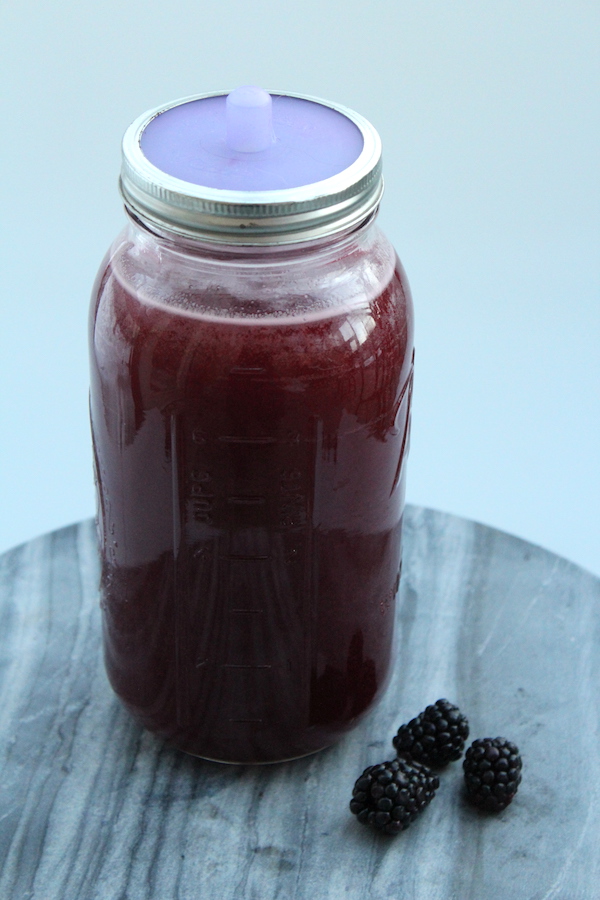
After a week in the primary fermenter, be it a towel-covered fermentation bucket or silicone water-locked mason jars, go ahead and rack the blackberry wine back into a narrow neck fermenter with a traditional waterlock once the fermentation slows down a bit.
Allow it to ferment in secondary for about 3 months, then rack again and leave it for 8 months to a year before bottling. Once bottled, age for at least 6 months before drinking.
So to recap:
- Ferment in primary for 1 week, watching for overflows, ideally in a bucket fermenter
- Secondary for 3 months
- rack again and leave for 8 to 12 months
- Bottle and age for at least 6 months.
All in all, this blackberry wine won’t be ready to drink for at least 18 months. Now I’m wishing I had made a 5-gallon batch…
I’ve written this recipe for a 1-gallon batch, but it can easily be multiplied by 5 for a full five-gallon batch. If you’ve only got a handful of blackberries and still want to give it a try, use a half-gallon or quart fermenter as I describe in this post on making small-batch wine.
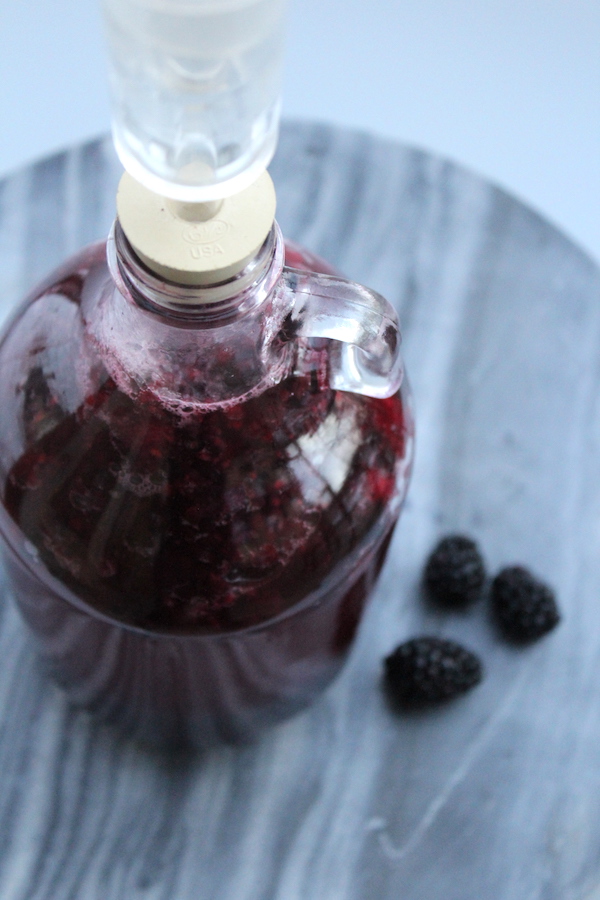
If you do adjust the recipe, all the ingredients can be scaled up or down accordingly, except the yeast.
A yeast packet is good for 1 to 5 gallons of liquid, and you can just use the whole packet for those volumes. The yeast multiplies quickly and you don’t need 5 packets of yeast for a 5-gallon batch, it’s just a seed quantity anyway.
With batches bigger than 5 gallons, go ahead and use more yeast.
Similarly, for small batches of less than 1 gallon, just use part of the packet. Seeding the batch with a whole packet will cause a really intense primary ferment, and this one’s already quite vigorous.
(Always make sure you sanitize all equipment before starting. I use One Step No-Rinse Sanitizer which is made for brewing and winemaking. It’s doesn’t leave a residue, and just ensures everything is clean before you get started so that there’s no wild yeast or other sources of contamination.)
Ways to Preserve Blackberries
Looking for more ways to preserve blackberries?
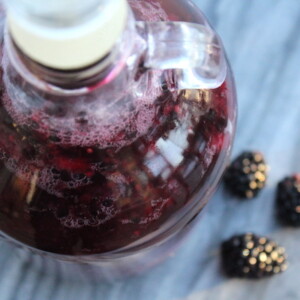
Blackberry Wine
Ingredients
- 4 lbs blackberries, fresh or frozen
- 2 1/4 lbs sugar, about 4 1/2 cups
- 1/4 tsp tannin powder
- 1 tsp acid blend
- 1/2 tsp Pectic Enzyme
- 1/2 tsp yeast nutrient
- 1 wine yeast, preferably sweet wine yeast
- water to fill
Instructions
- Sanitize all equipment.
- Smash blackberries and sugar together in a primary fermentation container.
- Bring 1 quart of water to a boil and pour over the blackberries and sugar. Stir to dissolve the sugar.
- Allow the mixture to cool to around 70 degrees and add the remaining ingredients, adding enough water to fill your 1-gallon fermenter.
- Seal the fermenter with a blow off tube (this ferments a bit violently for a water lock) or leave open for the first part of the primary ferment, just covered with a towel. Stir the mixture daily for 5-7 days until the most vigorous fermentation is complete.
- After about a week, wrack the blackberry wine into a glass carboy (narrow neck) and seal with a water lock. Allow the mixture to ferment for about 3 months before racking again.
- At this point, allow the mixture to ferment for 8-12 months before bottling.
- Allow the blackberry wine to bottle age at least 6 months before tasting.
Nutrition
Nutrition information is automatically calculated, so should only be used as an approximation.
Easy Country Wine Recipes
Looking for more homemade fruit wine recipes? I’ve got plenty to share…
Beer, Cider, and Mead Recipes
There’s more to drink than just wine you know…
- How to Make Beer at Home
- How to Make Mead (Honey Wine)
- Rose Wine (and Rose Mead)
- Lemon Balm Mead (Honey Wine)
- How to Make Hard Cider
- How to Make Pear Cider
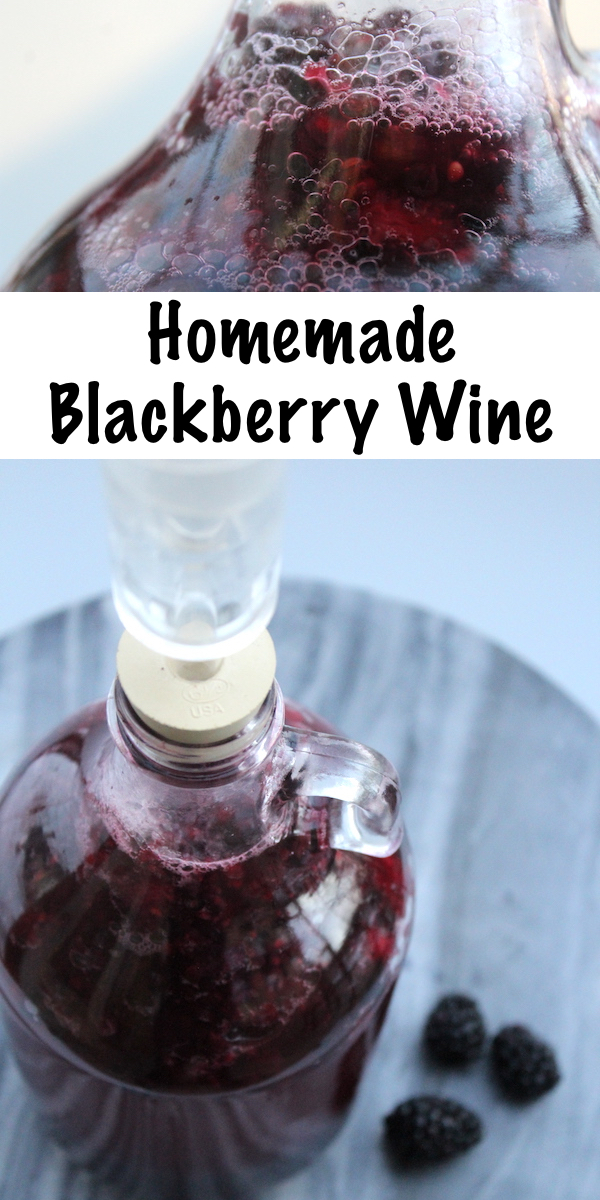



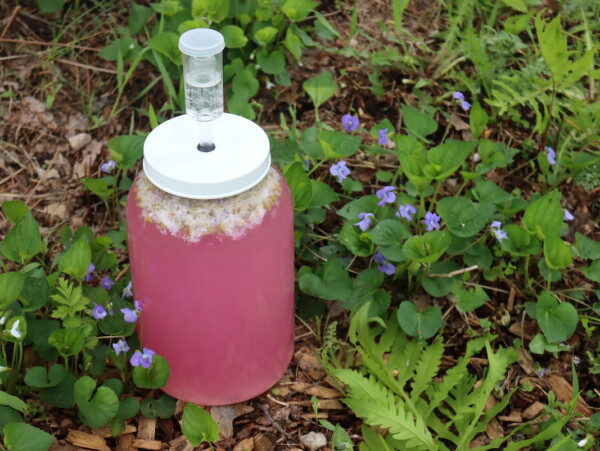










Could you please offer some measurements for using citric acid, lemon juice, or cream of tartar in place of the acid blend? Also, how much black tea to use in place of tannin powder?
I am on an Amazon ordering hiatus, so I’d like to use what I have at home. I have organic raisins, so no need for yeast nutrient. I have no pectic enzyme but I believe blackberries give up their juice easy enough to where it may not be totally needed.
If I can replace the two afore mentioned ingredients with adequate measure, then I can dive headfirst into your wonderful looking recipe! Our blackberry bushes are absolutely explosive this year, and I’m picking by the gallon daily.
Thanks so much for all your fantastic content, Ashley! I always know I can rely on the safety and efficacy of your posts.
~Megan
You don’t really want to use citric acid alone. The acid blend is a blend of several different acids and you won’t get the same results with the citric acid alone. You can however substitute lemon juice. You will want to use a tablespoon of lemon juice for every teaspoon of acid blend. For the tannin you can just brew a strong cup of black tea. Here is a great post that talks all about winemaking ingredients and substitutions that might be helpful as well. https://practicalselfreliance.com/winemaking-ingredients/
This is my first go with making wine….so I did my primary ferment in a wide mouth gallon jar with a coffee filter covering it. After ~10 days I strained out the berries and transferred to a narrow neck gallon jug. Since I strained out all the fruit, now the jug is about 2/3 full. I am using a water lock, but am noticing some gray spots forming on the surface. Is this too much air exposure and possibly mold forming? Anything I can do? (BTW I tasted it when racking it–it tastes like wine and is really good!:) ) Thank you!
I’m just now seeing this. How did your wine turn out? It does sound like you possibly had some mold growing.
I just bottled it after my last carbon ferment and it tasted good, so I think all is ok! I would like to start another batch and am wondering if I can heat up and de-seed the blackberries before the first ferment so I can start out with the full 4 pounds and not lose so much volume from straining out the berries? Or does heating them up affect the fermentation process?
Heating them won’t impact the fermentation process, but it does impact flavor. Cooked fruit doesn’t taste nearly as complex and wonderful as raw fruit. A better option would be to freeze the fruit, which will break them down, then thaw and press the mixture through a jelly bag, cheesecloth or fine mesh strainer to remove the pulp.
I am in the process of making this wine right now. I just wanted to ask why so long on each rack with this particular wine. I have made your dandelion wine recipe and it didn’t take that long. Sorry I am a newbie if this is a dumb question.
This recipe was actually adapted from The Home Winemakers Companion and follows the guidelines there. You may be able to get away with a shorter fermentation but I would encourage you to try this method and taste the results. The other factor here is the violent fermentation described in the post which obviously diminishes as time goes on.
Mine has been going for a week. When is a good time to remove the blackberries. It has been working in a stock pot with the spout at the bottom. It is ready for stage 2. I put 2 and a half gallons of water when i started is it to late to make a 5 gallon batch. Or is there something i can do? I am a new be and think i messed it up already. My first time. Thank you doe your time.
I would just start another batch if you want to do more. When you rack the wine into the secondary is the time to remove the blackberries.
Hello,
Looking to make wild blackberry wine with your recipe. What’s the difference between yeast nutrient and wine yeast? Do I still need to get both?
We have a great post here about winemaking ingredients that should answer all of your questions. Check it out and let us know if you have an other questions.
https://practicalselfreliance.com/winemaking-ingredients/
Hello there!
I’m a couple months into the process, About 2 months into the 8-12 month wait. My brew has stopped bubbling, any thoughts as to why or how to fix it? Otherwise if there’s no way to get it brewing again should I just bottle it at this point rather than wait 5 more months?
Best wishes to you!
So this is after the secondary ferment correct? At this point you really shouldn’t see a ton of activity.
Yes, after the secondary fermentation. I just wasn’t sure because I’m seeing absolutely no activity. But if that’s normal then I’ll continue to hold off! Thank you for the response!!
You’re very welcome.
Hi Ashley,
I am about to make blackberry wine for the first time using your recipe.
But just realised that US gallons are different from UK gallons, and to make things worse I am european living in UK.
Obviously I can make the conversions….but I am worried I will mix things up between all these different measurements.
Any chance you could do a metric list for ingredients using Liters /kg ?
I am also confused about how much water I need to add…
Regarding tannin powder, I have read blackberries have high tannin content, what happened if I dont add the tannin? Why do you use tannin?
Sorry, I am a newby…:)
Thanks
Raymond
I’m sorry but we only write our recipes in US measurements at this time. Here are some of the reasons for adding tannin to the wine: increased structure, increased mouthfeel, better taste, and longer shelf life. You can add something like black tea if you don’t want to use the tannin powder.
Hi Ashley, can I just check – when you rack for the second time to leave it for 8- 12 months should it have a water lock or just a regular stopper? Thank you!
It will still be fermenting during this time so you want to use a water lock and not a regular stopper.
Hi Ashley,
I love your recipes and posts – they are so inspiring! 🙂 You are the reason I got courage to try my hand in making wine at home 🙂
At the moment I have some blackberries, wild blueberries and strawberries in my freezer and I decided to make three wines with these berries. Each recipe for these berries calls for 1 tsp acid blend. Thing is, I live in Sweden and can’t find it here. Could I replace it with tartaric acid or citric acid? I think I can get my hands on some malic acid as well. Which acid would work best in those recipes and what quantities should I use?
Best wishes/ Diana
The acid blend actually is made up of 50 percent malic acid 40 percent citric acid and 10 percent tartaric acid. So if you think you can get your hands on all three, maybe you could just blend them together in this ration and then use the recommended amount from the recipe.
Hi Ashley, my blackberry wine has been going well and went into first rack Carboy about a month ago, can still see the occasional bubbles coming through the water lock so everything is looking well! One question, i have about 4 litres worth in a 5 litre Carboy and Ive noticed residue deposits as the Carby narrows into the neck. Is this normal? Or could this be mold? Just debating racking early!
Thanks so much for the recipe
I am going to guess that this residue is probably from the wine bubbling up into the neck and then receding. I would just keep an eye on it. You should be able to tell if it is actually mold.
Is it possible to leave out the pectic enzyme and use lemon juice instead of the acid blend?
Yup, both those changes are perfectly fine. The pectic enzyme is there to help the wine clear, it’s a cosmetic thing. To use lemon juice instead of acid blend, you’d put in 1 tablespoon of lemon juice for every teaspoon of acid blend in the recipe.
Hello I’m new to wine making a the instruction say to add 1 pack of yeast and 1 packet does up to 5 gallons. Is that to much for the one gallon that I’m making?
Also I’m using a 2 1/2 gallon ferment bucket and it said to add enough water to fill 1 gallon. Since I put 1quart in already I should just have to add 3 more quarts. Correct? Thanks!
You can use 1/4 of a packet for a 1 gallon batch. You want a total of a gallon of liquid for your batch.
I took one pound of frozen blackberries and 1.5 pounds of brown sugar and boiled with 1.5 gals of bottles water for a few minutes. Then added Belgium ale yeast at 70 degrees and poured into primary fermenter. Im looking to make something fizzy and 7%. Hydrometer was at 1.045 at 70 deg. before the berries were added. Fermentation is going crazy, you can hear it from 3 feet away. I will put in secondary w/ air lock after a few weeks. After that I will prime and bottle like beer. What am I making here?
Sounds like you might be making blackberry beer.
Would starting ferment in 1.5 gallon or 2 gallon carboy avoid bubble over or would added head space negatively affect the ferment?
Many people actually use open fermentation for blackberry wine so I don’t see that the added space would negatively affect the ferment.